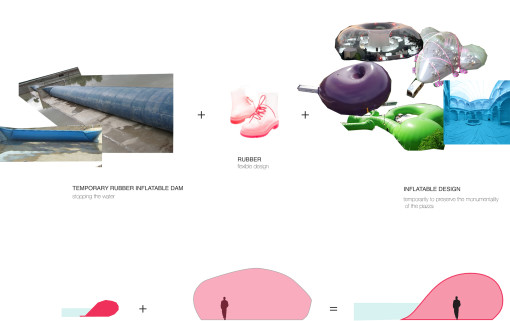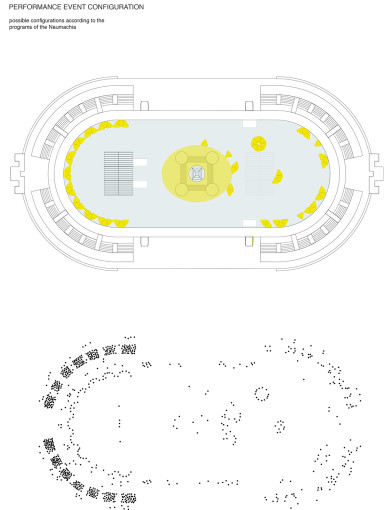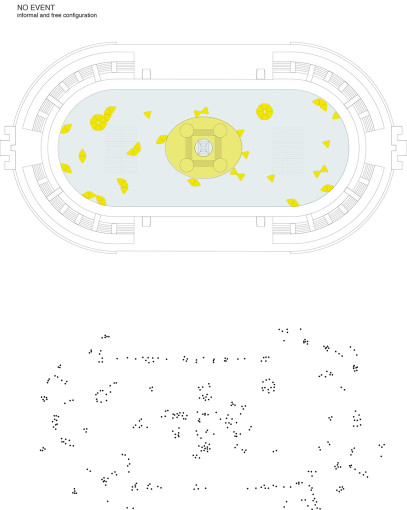NAUMACHIA by Paola Fortunato
The eternal city is many things, and water is one of its main components. Rome is its water: it was born on the water living from and belonging to it. With the water Romans built up their empire, creating magnificent architecture for water supply ; such as the famous aqueducts which conveyed water from distant springs and streams into Rome and the whole empire. The destiny of Rome has been discussed among the vapors of the thermal baths and its triumphs celebrated and simulated in big arenas filled of water (Naumachias). Water and stone have been shaped together to bring forth the astonishing presence of the baroque architecture. Water was the hearth of the city.
Water and wastewater systems and access points, indeed, were generally outside the household. Because of this lack of direct connection, Romans were forced to spend much of their time outside their tenements; in the shops, streets, latrines, baths, and arenas of the noisy, vibrant city.
This magic relationship now is over. Water, in its symbolic meaning, remains just a memory of the glorious past of Rome.
The eternal city forgot what made it eternal: the blonde river, once the lifeblood of Rome, flows alone with the cities refuse and memories. Aqueducts and baths are now dry and nostalgic ruins, and the Naumachias are mere illustrations in books beside the stories of the past triumphs of Rome. In Rome today, water and all its architecture is either ignored or has disappeared. It has been ‘museumificated’ as a result of the modernization the city has witnessed over the years. Water is now a disconnected monument to contemplate, the heart of the city doesn’t beat anymore.
On one hand the water is a passive presence in Rome; but on the other hand, the same modernization that extinguished its magic, is now forcing the water back into the city in the form of heavy rains which most of the times results in the overflowing of the Tiber and the flooding of some parts of the city which are not ready to accommodate this huge quantity of water. Consequently, this is generating an enormous waste of water.
Water is claiming its presence in the city asking for a new place to stay. Rome is choking under the effects of modernization and needs to reclaim its identity.
The question is, how to restore the water’s place in the life of Rome today, and then its identity? Can the water reappear to be a performance in the city?
The idea of the project develops and emerges from these questions. It is an example on how to renew and restore the water identity of Rome with a recreational purpose. By doing so, the water will play an active role again in the city and the lifestyle of its inhabitants.The monumental space par excellence, the piazzas, are used as amphitheaters accommodating temporarily this modern excess of water. The piazzas are then transformed into modern Naumachias for contemporary events and performances; on water.
NAUMACHIA TYPOLOGY
NAUMACHIA (in Latin naumachia, from the Ancient Greek ναυμαχία/naumachía, literally “naval combat”) in the ancient Roman world referred to both the staging of naval battles as mass entertainment and the basin (or more broadly, the complex) in which these battles took place.The Naumachie were used to celebrate past victories, naval battles or inaugurations. (fig. 1) The first known Naumachia was given by Julius Caesar in Rome in 46 BC on occasion of his quadruple triumph. Those basins were fed through aqueducts coming from lakes, or canals in the city connecting the Naumachia with the Tiber. (fig2) The most recent Naumachia in Rome (XVII – XIX century), piazza Navona, used to be flooded by simply closing the drain of the fountains present in the piazza.
By transforming the piazzas into Naumachias in this proposal, the special ancient city-water relationship would be re-established in a manner that befits our times. The water will again have a symbolic and scenographic role in Rome. The aim is to create network of Naumachias connecting all the monumental piazzas. The water enters the city as a performance, highlighting and reflecting the monumental and magnificent spaces of Rome. The water reaches the piazzas by using the modern excess of water: the rain and by taking advantage of the overflow of the Tiber. (fig 3)
NAUMACHIA POPOLO
Piazza del Popolo is a monumental square, the last great creation of papal Rome, and the representation of the patronage of the Pope. It is the hall of the city. It was once the setting for games, fairs and popular shows for centuries. It was also a place for public executions, the last of which took place in 1826. Nowadays the square is still used for big public events, such as concerts, protests, public talks etc. (fig 4-5) The piazza, transformed into a Naumachia, will keep its large scale use of the public space, but on water.
The intervention is interim, inspired by the inflatable architecture and inflatable dikes, which are temporary dikes used as water gates to prevent floods. The temporality of the project preserves and respects the monumentality of the piazzas. This new inflatable addition will be holding the water around the piazza, and at the same time it will accommodate functions inside (the tribunes and the circulation) and outside (exhibition, information point, ticket office etc) echoing the typologies of the ancient roman stadium amphitheater and the Naumachie. (fig. 6-7-8).
The inflatable element has a temporary steel structure holding the tribunes on top, providing seating and mobility for the public in the now water filled piazza. (fig. 13-14)
CONFIGURATIONS
The water in the naumachia facilitates different configurations according to the program of the Naumachia such as:
1. performance event (fig.9) : the stage is inflated on one of the sides of the piazza, while the other side is a free configuration. Or depending on the kind of performance the two stages can be inflated and used at the same time.
2. water games (fig.10) : the stages and the cushion are deflated to leave the space needed for water games. All the tribunes are occupied by the audience and the floating ones provide seating as well.
3. spread event (fairs, multiple participant event) (fig.11) : the stages are decomposed in smaller stages for fairs and spread events. The occupation of the public space is spread between the tribunes and the water
4. no event (fig.12): the configuration is totally free, so is the use and occupation of the public space.
OBELISK (fig. 17)
The obelisk in the center of the piazza is usually used as an island in the huge monumental space. It is a small reference point around which people gather, hanging out in its shadow beside the refreshing water of the fountains (fontane dei leoni). The role of the obelisk, in the project, is preserved by ‘inflating the island’, surrounding the obelisk with a big water cushion which is filled with water, turning the island into a fluffy and playful place. The island can be reached by the pedal boats.
MODULAR FLOATING TRIBUNES (fig. 15)
The floating tribunes are pedal boats; the triangular shape and incorporation of the pedals allows them to move in the water in order to create various configurations according to the event taking place in the Naumachia. They can be used either as simple ‘floating theatre seating’ (performance event), or assembled around the modules of the stage (spread event), or just as a free configuration in order to move around in the naumachia when there is no event.
FLOATING MODULAR STAGE (fig. 16)
The stage is composed of modular squared elements. Each module includes inflatable elements which are filled with air when the stage is needed, creating a floating stage. When the stage is not needed, they are deflated and sunk under water.
In this way, the stage appears and disappears from the water forming different elements according to the current event. In the case of a spread event, the stage is decomposed and each module is surrounded by the floating tribunes pedal boats.
Related Posts :
Category: Article
Views: 6335 Likes: 3
Tags: rome , rome and water , water
Comments:
Info:
Info:
Title: NAUMACHIA by Paola Fortunato
Time: 10 aprile 2014
Category: Article
Views: 6335 Likes: 3
Tags: rome , rome and water , water
























